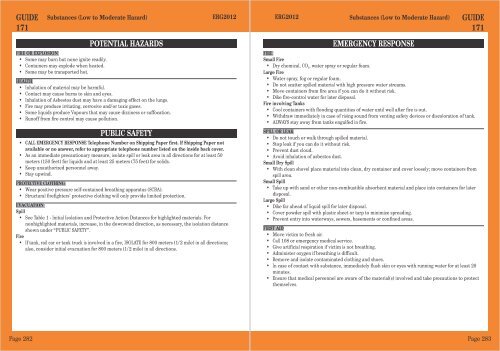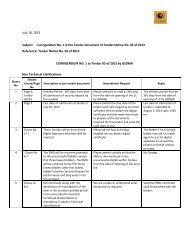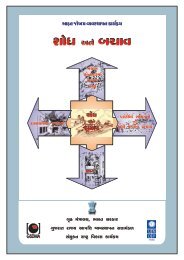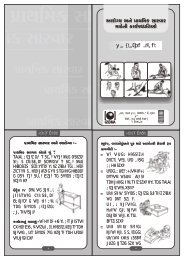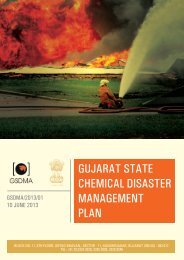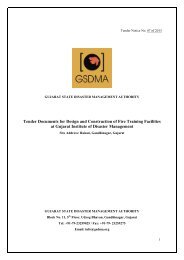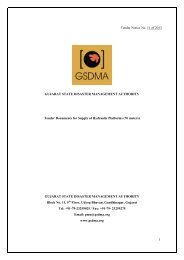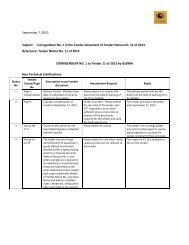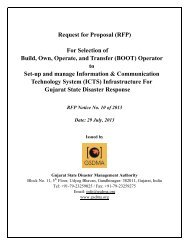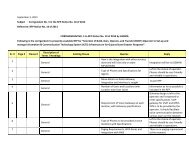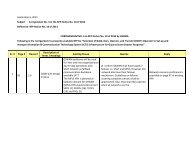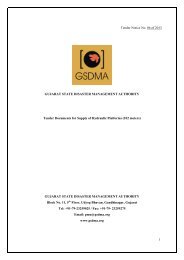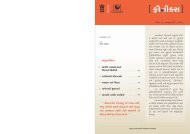Emergency Response Guidebook - Gujarat State Disaster ...
Emergency Response Guidebook - Gujarat State Disaster ...
Emergency Response Guidebook - Gujarat State Disaster ...
Create successful ePaper yourself
Turn your PDF publications into a flip-book with our unique Google optimized e-Paper software.
GUIDE171Substances (Low to Moderate Hazard)ERG2012ERG2012Substances (Low to Moderate Hazard)GUIDE171FIRE OR EXPLOSION• Some may burn but none ignite readily.• Containers may explode when heated.• Some may be transported hot.POTENTIAL HAZARDSHEALTH• Inhalation of material may be harmful.• Contact may cause burns to skin and eyes.• Inhalation of Asbestos dust may have a damaging effect on the lungs.• Fire may produce irritating, corrosive and/or toxic gases.• Some liquids produce Vapours that may cause dizziness or suffocation.• Runoff from fire control may cause pollution.PUBLIC SAFETY• CALL EMERGENCY RESPONSE Telephone Number on Shipping Paper first. If Shipping Paper notavailable or no answer, refer to appropriate telephone number listed on the inside back cover.• As an immediate precautionary measure, isolate spill or leak area in all directions for at least 50meters (150 feet) for liquids and at least 25 meters (75 feet) for solids.• Keep unauthorized personnel away.• Stay upwind.PROTECTIVE CLOTHING• Wear positive pressure self-contained breathing apparatus (SCBA).• Structural firefighters’ protective clothing will only provide limited protection.EVACUATIONSpill• See Table 1 - Initial Isolation and Protective Action Distances for highlighted materials. Fornonhighlighted materials, increase, in the downwind direction, as necessary, the isolation distanceshown under “PUBLIC SAFETY”.Fire• If tank, rail car or tank truck is involved in a fire, ISOLATE for 800 meters (1/2 mile) in all directions;also, consider initial evacuation for 800 meters (1/2 mile) in all directions.EMERGENCY RESPONSEFIRESmall Fire• Dry chemical, CO 2, water spray or regular foam.Large Fire• Water spray, fog or regular foam.• Do not scatter spilled material with high pressure water streams.• Move containers from fire area if you can do it without risk.• Dike fire-control water for later disposal.Fire involving Tanks• Cool containers with flooding quantities of water until well after fire is out.• Withdraw immediately in case of rising sound from venting safety devices or discoloration of tank.• ALWAYS stay away from tanks engulfed in fire.SPILL OR LEAK• Do not touch or walk through spilled material.• Stop leak if you can do it without risk.• Prevent dust cloud.• Avoid inhalation of asbestos dust.Small Dry Spill• With clean shovel place material into clean, dry container and cover loosely; move containers fromspill area.Small Spill• Take up with sand or other non-combustible absorbent material and place into containers for laterdisposal.Large Spill• Dike far ahead of liquid spill for later disposal.• Cover powder spill with plastic sheet or tarp to minimize spreading.• Prevent entry into waterways, sewers, basements or confined areas.FIRST AID• Move victim to fresh air.• Call 108 or emergency medical service.• Give artificial respiration if victim is not breathing.• Administer oxygen if breathing is difficult.• Remove and isolate contaminated clothing and shoes.• In case of contact with substance, immediately flush skin or eyes with running water for at least 20minutes.• Ensure that medical personnel are aware of the material(s) involved and take precautions to protectthemselves.Page 282Page 283


